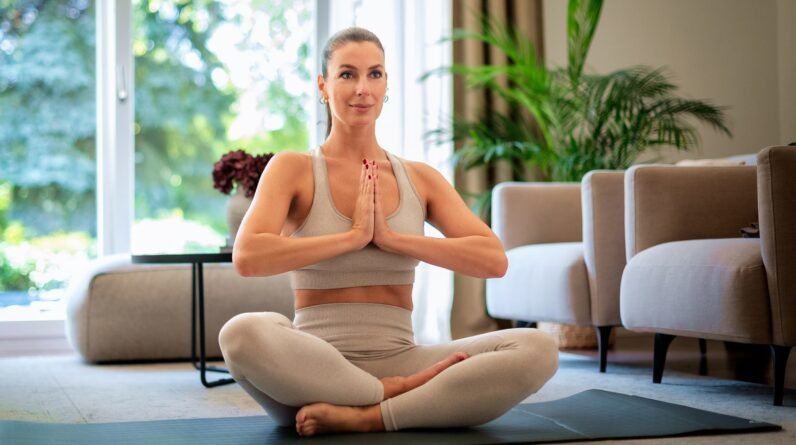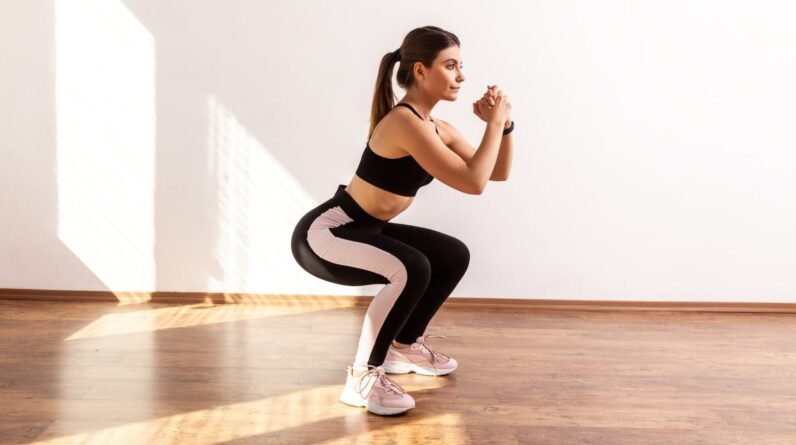
Ready to give gentle movement a try? Read on to learn more about what it is, why it’s beneficial, and how to add it into your existing routine.
What is gentle movement, anyway?
Gentle movement is the idea that slowing down and participating in activities while fully present and in a way that is kind to your mind and body can improve your mental and physical wellness.
Jenny Flora Wells, MSW, LSW, ACSW, a holistic therapist and licensed social worker, defines gentle movement as practices that help you flow in the same rhythm as a healthy nervous system.
“Gentle movement includes yoga, Pilates, meditation, walking, tai chi, easy swimming, and even gardening,” Wells says. “Gentle movement helps us reconnect with a slower pace in a world that’s constantly moving at a very fast pace.”
There’s no definitive list of gentle movement activities, but practices that allow you to physically and mentally slow down or find respite from daily mental and physical stress and don’t measure their success by calories burned or pounds lost generally qualify as gentle movement.
“Ancestrally, humans were not meant to move through life as quickly as we do today,” Wells says. “In today’s world, it’s not uncommon to be stuck in an unregulated nervous system, leading to anxiety, headaches, restlessness, and more. The goal of gentle movement is to provide a space in which we can allow ourselves to move in a slower, deliberate way and bring our nervous systems back into balance and out of fight or flight mode.”
What are the benefits of gentle movement?
While it can be hard to quantify the ways in which gentle movement can improve health and wellness, one January 2017 study in Oxidative Medicine and Cellular Longevity found that in a group of 96 individuals, a 12-week yoga and meditation practice improved “cardinal and metabotrophic biomarkers of cellular aging compared to baseline values,” implying that gentle movement may be able to slow or improve aging and its challenges in adults.
In addition to helping regulate your nervous system, gentle movement can also improve your ability to be present and foster a strong mind-body connection, according to Theresa Barone, senior manager of Pilates at Life Time, who has more than 500 hours of Pilates training under her belt.
“The mind-body connections created through classical Pilates work helps improve muscle firing patterns while being gentle on the joints and leveraging total focus on the body, which allows participants to let go of their stress and shut out the proverbial ‘laundry list’ of things they need to complete after class,” Barone says. “Redirecting the mind to focus on one’s mind, body, and breath leaves Pilates students feeling much better physically, mentally, and emotionally than when they first arrived to class.
Barone echoes Wells in that gentle movement, such as Pilates, can assist in achieving a calmer nervous system.
“Intense workouts can be fun and leave us dripping in sweat with the feeling that we ‘got the job done’ in the workout,” Barone says. “But gentle movements, like Pilates, can help facilitate our parasympathetic nervous system—the ‘rest and digest’ system. There are a plethora of activities to up-regulate our nervous system, such as hard workouts, the news, and social media, but not many that can help to regulate the parasympathetic nervous system, which is why practices like Pilates can be beneficial and facilitate improved sleep quality, energy levels, and the ability to cope with stress.”
Gentle movement can also help you recover from the “wear and tear on our bodies” from activities such as HIIT-style workouts or other high-impact activities whose focuses may be on burning calories or building muscle, according to Barone.
“Pilates and other gentle movements, like yoga, helps prevent injury through postural work and balancing muscle groups,” she says. “Breath is particularly accentuated in Pilates and yoga and pulls one exercise into the next creating flowing, nonstop movement for an entire session that is still gentle on the body.”
“The goal of gentle movement is to provide a space in which we can allow ourselves to move in a slower, deliberate way and bring our nervous systems back into balance and out of fight or flight mode.” —Jenny Flora Wells, MSW, LSW, ACSW
Using the ‘Alexander Technique’ as gentle movement
One of the original forms of gentle movement is the Alexander Technique. The Alexander Technique was created in the 1890s by Frederick Alexander, an Australian performing arts professional who wanted to be more in touch with his body and how it habitually moved in different ways from years of performing and how that affected his overall health.
Today, the Alexander Technique is still practiced by thousands of people worldwide and involves breathwork, muscular control, and body awareness.
Unlike traditional meditation, the Alexander Technique requires you to be awake, present, and aware of how you’re holding your body. It’s especially beneficial to those whose lives involve frequently repeated movements, such as musicians, dancers, runners, and swimmers.
Sumi Komo, a Boulder, Colorado-based Alexander Technique instructor, describes the technique as being focused on “conscious awareness of the body and acknowledging that humans have habitual ways of moving, speaking, and holding ourselves.”
The Alexander Technique can involve practices as simple as learning how to lengthen your spine and breathe better when attempting to stand up from a sitting position, according to Komo.
“The Alexander Technique fundamentally teaches you how to move better and how to be more balanced,” she says. “The Alexander Technique is truly a gentle movement practice for anyone and anybody.”
The Alexander Technique is often described as a “psychophysical re-education,” according to Alexander Technique instructor Molly Kittle. It’s an ongoing study of your body, breath, self-awareness, and mind.
“The Alexander Technique is a study of oneself that helps a person recognize and consciously release unnecessary patterns or habits of tension so that any movement can be easier or more efficient,” Kittle says. “Part of this study is the exploration of the psychophysical relationship we have with ourselves—the mind-body connection.”
How to incorporate gentle movement into your life
Even though it is called “gentle movement,” it may feel disruptive to your existing routine to try to suddenly add multiple sessions of gentle practice to your schedule.
The common trope in today’s society of “just pause and slow down” isn’t the right way to incorporate gentle movement into your life, Wells says. Instead, she suggests easing into a gentle movement practice that resonates with you, whether that be yoga, tai chi, Pilates, or another form of easy, enriching movement.
“Dedicating even five minutes a week to that gentle movement practice is a great way to start,” Wells says. “It may be hard at first to be comfortable with that slower pace or stillness for a variety of physical and mental reasons. If immersing yourself in gentle movement is difficult at first, I suggest narrating to yourself what you’re observing in that moment, such as noticing what thoughts and feelings arise and staying open and curious to what comes up during these practices.”
Wells recommends resources such as online yoga classes and guided meditations, as well as apps such as Insight Timer, Headspace, or Calm as good starting places for a variety of instructor-led gentle movement practices.
Barone also suggests beginning a gentle movement practice slowly and with intention.
“While going straight to a Pilates class is enticing, there are key components that can be missed by the student by doing this,” she says. “If possible, start with a private Pilates class, which is offered by many gyms and studios. This allows Pilates instructors to get to know you, your goals, and your body. It also provides you with time and space to connect with your mind and body before diving into a full-on class.”
For Pilates specifically, Barone recommends incorporating Pilates twice a week to complement other, more intense activities.
Despite seeming like one of the simplest gentle movement practices, the Alexander Technique can be difficult and frustrating without an instructor—at least to start.
Both Komo and Kittle highly suggest working with an Alexander Technique teacher—in person if possible, online if not—to begin your psychophysical re-education journey.
“Learning the Alexander Technique is best done with an instructor—the journey is so physical that it’s much better to experience it with a teacher who can guide you through the principles of the work,” Kittle says. “The goal of the work is to empower people to be able to integrate the ideas of the Alexander Technique for themselves, so it’s not as if they may need an instructor for the rest of their lives. But to start, an instructor is optimal.”
There are a variety of activities and practices that qualify as gentle movement. Experiment with different modalities to find the gentle movement regimen that resonates with you. After all, the point of any gentle movement practice is to help you find centeredness, joy, and connection with the most important person in your life: yourself.
Well+Good articles reference scientific, reliable, recent, robust studies to back up the information we share. You can trust us along your wellness journey.
- Tolahunase M, Sagar R, Dada R. Impact of Yoga and Meditation on Cellular Aging in Apparently Healthy Individuals: A Prospective, Open-Label Single-Arm Exploratory Study. Oxid Med Cell Longev. 2017;2017:7928981. doi: 10.1155/2017/7928981. Epub 2017 Jan 16. Erratum in: Oxid Med Cell Longev. 2017;2017:2784153. doi: 10.1155/2017/2784153. PMID: 28191278; PMCID: PMC5278216.







